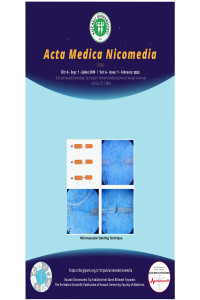Evaluation of the Frequency of Malnutrition in Children and Adolescents Referred to Pediatric Endocrinology Outpatient Clinic for Short Stature
Abstract
Objective: The aim of this study was to describe the characteristics and the etiological factors of children and adolescents and the prevalance of malnutrition with the complaint of short stature.
Methods: This retrospective study was conducted in the pediatric endocrinology outpatient clinic of a tertiary care city hospital in Turkey, between May 2019 and May 2021. Patients aged 1-18 years who were referred to the pediatric endocrinology outpatient clinic because of short stature were included in the study. Short stature was defined as a height below the third percentile for the corresponding age and gender in the Turkish children’s growth chart. Mild malnutrition was defined as BMI SDS (body mass index standart deviation score) between -1 and -2, moderate malnutrition between -2 and -3 and severe malnutrition less than -3.
Results: The study included 980 patients aged between 1 and 18 years. Forty-five percent of the patients were female (n=444) and 55% (n=536) were male. Height SDS was less than -2 SDS in 408 patients, while 572 (58%) patients had a height SDS value greater than -2 SDS. When the whole group was evaluated, 38% of the cases (n:371) had a BMI SDS value less than -1 and had varying degrees of malnutrition. There was no statistically significant difference between girls and boys in the distribution of malnutrition according to gender (p:0,46).
Conclusion: Results of our study indicate that stunting due to protein-energy deficiency is still a serious health problem in our country and mild malnutrition can be easily overlooked.
Keywords
References
- 1. Collett-Solberg PF, Jorge AAL, Boguszewski MCS, et al. Growth hormone therapy in children; research and practice - A review. Growth Horm IGF Res. 2019;44:20-32. doi:10.1016/j.ghir.2018.12.004
- 2. Cohen P, Rogol AD, Deal C, et al. Consensus statement on the diagnosis and treatment of children with idiopathic short stature: a summary of the Growth Hormone Research Society, the Lawson Wilkins Pediatric Endocrine Society, and the European Society for Paediatric Endocrinology Workshop. J Clin Endocrinol Metab. 2008;93(11):4210-4217. doi:10.1210/jc.2008-0509
Boy Kısalığı Nedeniyle Pediatrik Endokrinoloji Polikliniğine Başvuran Çocuk ve Ergenlerde Malnütrisyon Sıklığının Değerlendirilmesi
Abstract
Amaç: Bu çalışmanın amacı, boy kısalığı şikayeti olan çocuk ve ergenlerde klinik bulguları, etiyolojik faktörleri ve malnütrisyon sıklığını tanımlamaktır.
Yöntem: Bu retrospektif çalışmada, Mayıs 2019 ile Mayıs 2021 tarihleri arasında Türkiye'de üçüncü basamak bir şehir hastanesinin çocuk endokrinoloji polikliniğine boy kısalığı nedeniyle yönlendirilen 1-18 yaş arası olgular değerlendirildi. Boy kısalığı Türk çocuklarının büyüme eğrilerine göre boyun -2 standart deviasyon skoru (SDS) altında olması olarak tanımlandı. Hafif malnütrisyon vücut kitle indeksi SDS değerinin -1 ile -2 arasında, orta malnütrisyon -2 ile -3 arasında ve ağır malnütrisyon -3'ün altında VKi SDS (vücut kitle indeksi standart deviasyon skoru) olarak tanımlandı.
Bulgular: Çalışmaya yaşları 1 ile 18 arasında değişen 980 hasta dahil edildi. Hastaların %45'i kız (n=444) ve %55'i (n=536) erkekti. Boy SDS değeri 408 hastada -2 SDS'den düşükken, 572 (%58) hastada -2 SDS'den yüksekti. Tüm grup değerlendirildiğinde, vakaların %38'inin (n:371) VKİ SDS değeri -1'den düşüktü ve çeşitli derecelerde malnütrisyonu vardı. Malnütrisyonun cinsiyete göre dağılımında kız ve erkek çocuklar arasında istatistiksel olarak anlamlı bir fark bulunmadı (p:0,46).
Sonuç: Çalışmamızın sonuçları, protein-enerji eksikliğine bağlı bodurluğun ülkemizde hala ciddi bir sağlık sorunu olduğunu ve hafif malnütrisyonun kolayca gözden kaçabileceğini göstermektedir.
Keywords
References
- 1. Collett-Solberg PF, Jorge AAL, Boguszewski MCS, et al. Growth hormone therapy in children; research and practice - A review. Growth Horm IGF Res. 2019;44:20-32. doi:10.1016/j.ghir.2018.12.004
- 2. Cohen P, Rogol AD, Deal C, et al. Consensus statement on the diagnosis and treatment of children with idiopathic short stature: a summary of the Growth Hormone Research Society, the Lawson Wilkins Pediatric Endocrine Society, and the European Society for Paediatric Endocrinology Workshop. J Clin Endocrinol Metab. 2008;93(11):4210-4217. doi:10.1210/jc.2008-0509
Details
| Primary Language | English |
|---|---|
| Subjects | Paediatrics |
| Journal Section | Research Articles |
| Authors | |
| Publication Date | February 28, 2023 |
| Submission Date | January 11, 2023 |
| Acceptance Date | January 29, 2023 |
| Published in Issue | Year 2023 Volume: 6 Issue: 1 |
The articles in the Journal of "Acta Medica Nicomedia" are open access articles licensed under a Creative Commons Attribution-ShareAlike 4.0 International License at the web address https://dergipark.org.tr/tr/pub/actamednicomedia


